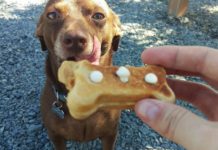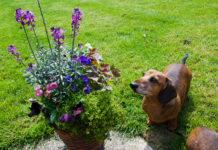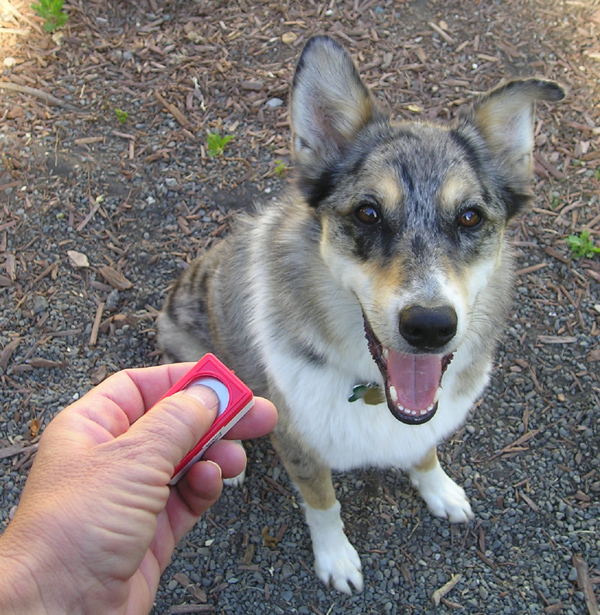The dog clicker is a great tool to teach your dog new behaviors. It has a very distinctive sound that dogs can easily identify with and pay very special attention to. Another benefit of using the clicker is that, unlike the sound of your voice, which can vary slightly depending on a number of factors, it makes the same sound every time, which is very beneficial in dog training. Before you can use the dog clicker in your obedience training sessions, you need to teach your dog what the “click” means and why hearing it is such a rewarding thing for him.
An Introduction to Dog Clicker Training
The dog clicker, in dog training terminology, is used as a Conditioned Reinforcer. Conditioned reinforcers are things (sounds,objects, words, behaviors) that initially have no real relevance to your dog; however, after some simple training associations, they will become very meaningful to him. They will tell the dog that he has made the correct choice and he will be rewarded for it.
Think of conditioned reinforcers as bridges. They connect behaviors you want your dog to perform (for example, sit) to the reward the dog gets by doing those behaviors (sitting). By clicking at the exact moment your dog sits down, he knows exactly when he’s done the correct thing to get his reward. This allows both of you to communicate in a commonly understood “language” and work towards common goals in your training.
In order for the dog clicker to have some real meaning in the “Sit” example above, we have to associate some positive value to it. Initially, it means nothing to the dog. It’s just an object made of plastic and metal that makes a noise.
How the clicker does become meaningful to your dog, is by pairing the sound it makes to something that your dog considers rewarding. The dog clicker then takes on a new meaning. It has life and can be used in all positive training sessions with your dog. Your dog will know whenever he hears that distinctive “click”, he’s done something you approve of and will receive a reward.
The rewarding items the dog clicker gets paired with can be anything your dog considers rewarding. They can be food objects, toys, praise and petting, etc. Basically anything your dog really likes can be used; however, the dog must set the value on the items, not the human.
To get the most bang for your buck (or your click), food is an excellent choice to start with. Food is a necessity of life, readily available, and most dogs will work pretty diligently for it. It’s great to use in training because you can very quickly and continuously use it to reward your dog without having to take it back from him, as is the case with using toys. This keeps the training sessions short, rewarding and fun.
So, to kick-start your dog clicker training and give the clicker some real meaning to your dog, you are going to pair or associate the sound of the click to the rewards you have chosen. You aren’t training your dog to DO anything at this point. You are simply building power into the clicker. You’ll find that you’ll have your dog’s undivided attention after doing just a handful of reps with him. This is actually a nice side-effect of using to the clicker.
Kick-Startin’ Your Dog Clicker Training
- Step One – Get approximately ten very soft and small (pea-sized) food treats your dog really likes.
- Step Two – In a non-distracting environment (living room, family room, kitchen, etc..), place the treats where you can get to them quickly, but where your dog can’t. Make sure the treats aren’t distracting the dog.
- Step Three – At random, click the clicker and immediately toss a treat to the dog. Make sure you click before you give the dog the treat. Your dog can be doing anything when you click, just as long as he isn’t doing anything you consider unacceptable, such as barking, jumping, biting, etc.. As long he is neutral or performing some type of acceptable behavior, keep clicking.
- Step Four – Try to wait, at times, for him to direct his attention to something else before you click and treat. Watch TV for a few minutes, read a book, try to ignore him a little so he forgets a little bit about the clicker. Then click again. This really builds clicker power. Also try to make the dog do something different each time you click and treat. Just wait, the dog will do something different, if not, you can make something change.
Here’s a sample routine:
- Wait two seconds – CLICK/TREAT
- Wait ten seconds – CLICK/TREAT
- Dog walks across floor – CLICK/TREAT – Wait ten seconds
- Dog looks at you – CLICK/TREAT – Wait five seconds
- Dog looks away – CLICK/TREAT – Wait fifteen seconds
Perform this about ten times. That’s one training session. Try to do this at least twice a day. If you can squeeze in 3 sessions, great!
Again, you really want to keep the dog guessing as to when the clicking sound will happen. So really try to fake him out and randomize your clicks. Move around the room. Ignore your dog. Go about your business as if the dog wasn’t even there and keep clicking. Go in different rooms and practice. Just make sure you’re dog isn’t doing anything inappropriate or you will wind-up rewarding that inappropriate behavior.
You will notice after doing a few sessions of this (probably even sooner) that your dog will catch on and begin to direct his attention towards you whenever he hears the click.
“Great Job!!! That means that your clicker kick-startin’ is really working.”
Once you notice the dog is really catching on to the dog clicker, change the reward from food; to petting; to food; to a favorite toy; to going for a walk when he turns his attention towards the clicker. You want to associate all types of rewards to the dog clicker. Remember to keep mixing in the food though.
Also, vary the time in between the click and the reward. In the beginning of clicker kick-startin’, the reward immediately follows the click. Once the dog has the idea, try the following routine during your practice sessions:
- CLICK – wait a half second, then give reward
- CLICK – wait one full second then give reward
- CLICK – give reward immediately
- CLICK – wait two seconds then give reward
Try to keep the delay to a second or two, three seconds at most. We want the dog to make an association between the dog clicker and the reward. Waiting too long before the reward gives the dog a chance to perform an inappropriate activity after the click.
“Keep practicing. Just always make sure that some sort of reward follows the click. Keep the clicker charged!!”
Useful Dog Clicker Food for Thought!
Try to factor in the amount of food you are using for rewards during your training sessions into your dog’s daily food rations. This will reduce the chance of you having an overweight pet.
Because of the distinct, consistent sound of the clicker, dogs will identify with it quicker and it will help build behaviors faster.
If your dog is afraid of the clicker, try muffling it a little in your pocket or try wrapping a paper towel around it. Little by little you can get your dog used to the sound it makes. Some dog clickers even have different clicking sound levels.
If your dog isn’t interested in the rewards you’re giving him, try other rewards. Experiment to find something he really likes.
Practice your dog clicker timing: Drop a tennis ball or one of the dog’s toys on the ground and try to time your click exactly as it hits the ground. Timing is key for training. Try tossing the ball to a friend and time your click as soon as it hits his or her hands.
“Practice makes perfect!!!”













